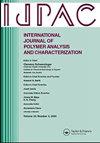Investigation of the mechanical behavior of AL7075 plate supported hybrid composite plates using artificial neural networks algorithm
IF 1.6
4区 工程技术
Q4 POLYMER SCIENCE
International Journal of Polymer Analysis and Characterization
Pub Date : 2025-07-04
DOI:10.1080/1023666X.2025.2491030
引用次数: 0
Abstract
The mechanical behavior of the hybrid structure formed by placing an AL7075 plate as the middle layer between different composite fibers was examined. Glass fiber and carbon fiber were preferred as fibers. Epoxy was used as matrix material. Four different cases with different fiber material layer alignments were examined. The produced plates were cut according to ASTM standards suitable for the tests to be performed, and samples were created. The samples were subjected to tensile tests, three-point bending tests, and ballistic tests. It has been determined that samples produced in sequential order with different layers reached high stress values in tensile tests and bending tests. It was observed that all alignments gave successful results in ballistic tests. In layered hybrid structures, the mechanical effects of the layer order and the type of material used on the hybrid structures have been demonstrated. The Levenberg-Marquardt algorithm with artificial neural networks was applied to investigate the appropriateness of the results. The results were presented to be appropriate in the graphs created with artificial neural networks, and it could be said that they were compatible. It can be said that more effective results are obtained in the combinations of carbon/glass/carbon and glass/carbon/glass composite fibers in layer arrangements.
基于人工神经网络算法的AL7075板支混合复合材料板力学行为研究
研究了AL7075板作为复合纤维中间层形成的混杂结构的力学性能。首选玻璃纤维和碳纤维作为纤维。环氧树脂为基体材料。研究了四种不同纤维材料层排列方式的情况。根据适用于要进行的试验的ASTM标准对所生产的板材进行切割,并创建样品。试样进行了拉伸试验、三点弯曲试验和弹道试验。在拉伸试验和弯曲试验中,按不同层序生产的样品达到了较高的应力值。据观察,所有对准都在弹道试验中取得了成功的结果。在层状混杂结构中,证明了层序和材料类型对混杂结构的力学影响。采用人工神经网络的Levenberg-Marquardt算法对所得结果的适宜性进行了检验。结果表明,用人工神经网络创建的图形是合适的,可以说它们是兼容的。可以说,碳/玻璃/碳和玻璃/碳/玻璃复合纤维的层状排列组合获得了更有效的结果。
本文章由计算机程序翻译,如有差异,请以英文原文为准。
求助全文
约1分钟内获得全文
求助全文
来源期刊
CiteScore
3.50
自引率
5.30%
发文量
37
审稿时长
1.6 months
期刊介绍:
The scope of the journal is to publish original contributions and reviews on studies, methodologies, instrumentation, and applications involving the analysis and characterization of polymers and polymeric-based materials, including synthetic polymers, blends, composites, fibers, coatings, supramolecular structures, polysaccharides, and biopolymers. The Journal will accept papers and review articles on the following topics and research areas involving fundamental and applied studies of polymer analysis and characterization:
Characterization and analysis of new and existing polymers and polymeric-based materials.
Design and evaluation of analytical instrumentation and physical testing equipment.
Determination of molecular weight, size, conformation, branching, cross-linking, chemical structure, and sequence distribution.
Using separation, spectroscopic, and scattering techniques.
Surface characterization of polymeric materials.
Measurement of solution and bulk properties and behavior of polymers.
Studies involving structure-property-processing relationships, and polymer aging.
Analysis of oligomeric materials.
Analysis of polymer additives and decomposition products.

 求助内容:
求助内容: 应助结果提醒方式:
应助结果提醒方式:


